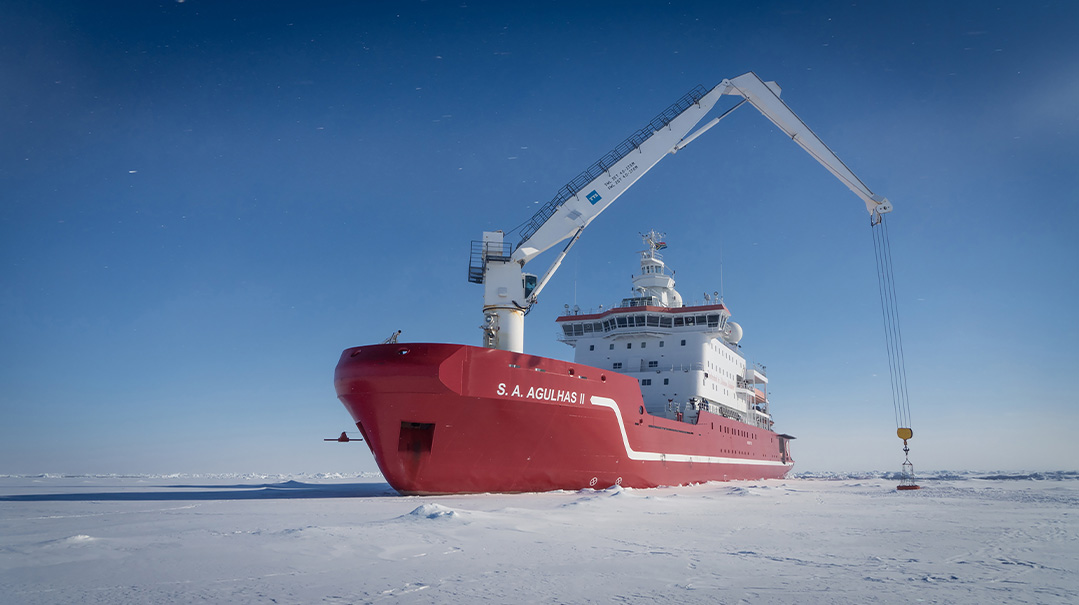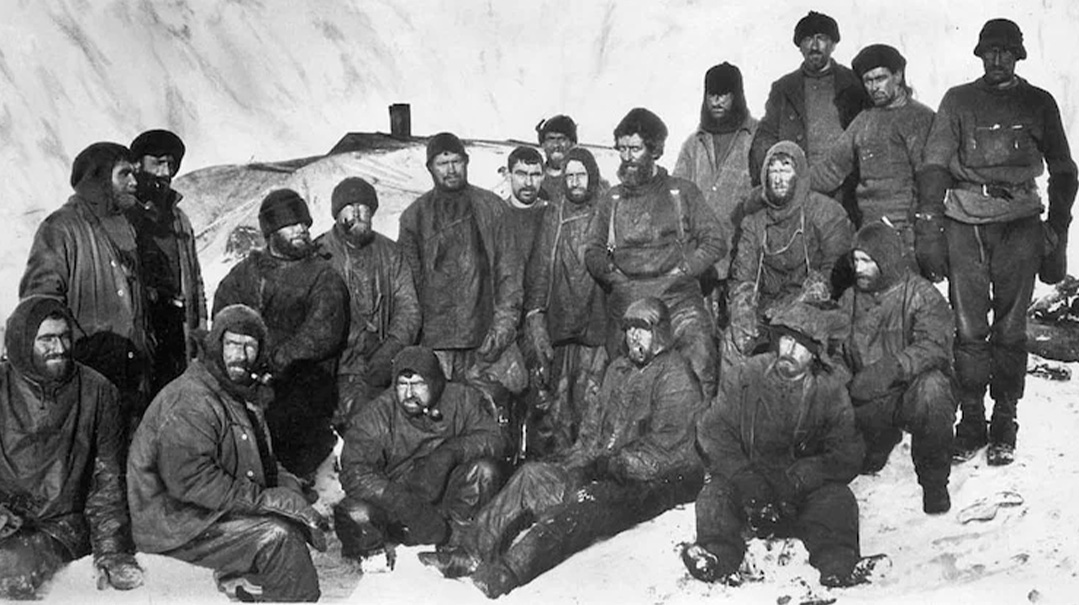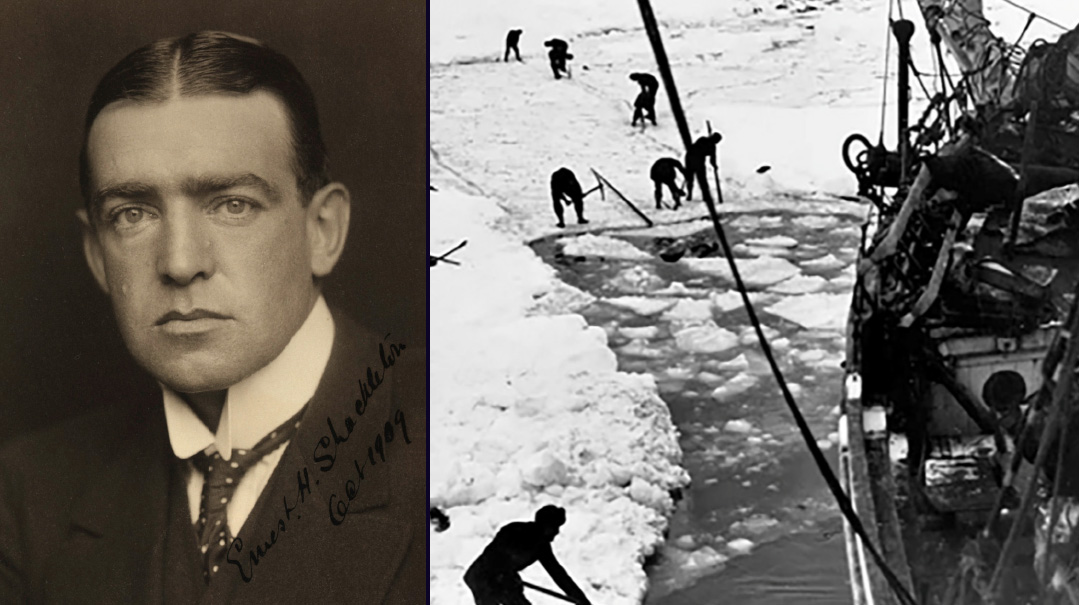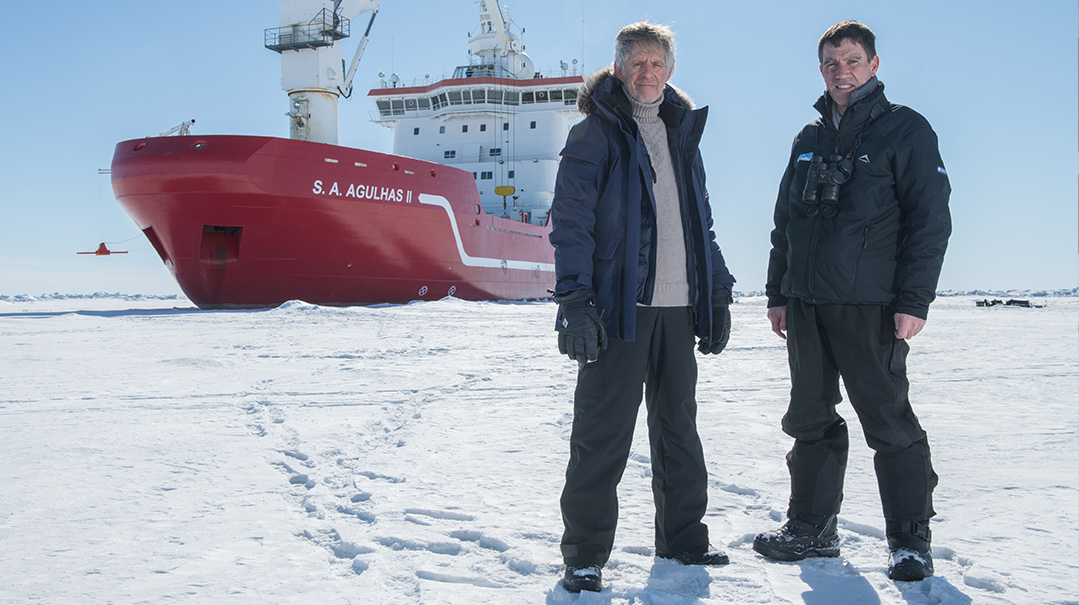Beyond Endurance

A century after Endurance sank, modern explorers found the ship intact, as if it were waiting 107 years for its sailors to return

Photos: Falklands MaritimeHeritage Trust / National Geographic, Esther Horvath
If you ever wanted to hide something huge and make sure no one would ever find it, you couldn’t pick a better place than the bottom of the Weddell Sea.
Off the coast of Antarctica, the Weddell Sea is a far-out frozenness where nobody finds anything except seals and penguins and subzero weather that covers your beard in icicles and makes you wish you’d stayed home.
That’s where polar explorer Sir Ernest Shackleton’s ship Endurance finally went down to the bottom, back in 1915, after being stranded and locked in ice floes for several months. In all the years since, although the entire crew survived, the world wondered whether the supposedly indestructible ship that sank in those forbidding waters would ever be found.
Perhaps some fragments, broken pieces of hull or mast might someday be discovered to tell a partial tale, at least provide a clue, to the fate of that vessel, built specifically to withstand the harsh Antarctic conditions.
The place where Endurance went down lies some 1,473 miles from Punta Arenas, the southernmost tip of South America. The nearest non-postal zones bear names like Elephant Island, South Georgia, Queen Maud Land, King Haakon VII Sea, and the least hospitable address of all — the South Pole.
And if you ever managed to get there — and there means an area of a million square miles — locating the wreck would seem like a hopeless endeavor. Because Endurance sank to a depth of 9,024 feet, at the bottom of the Weddell Sea.
Yet if you’re an adventurer obsessed with the drama of shipwrecks and drawn to the sheer power and energy of the open seas, you’ll keep looking. And that’s what happened on March 5, 2022, with a remarkable expedition named Endurance22. The Endurance was finally found, almost all of it intact and preserved in its dark, frigid underwater grave.
But that’s the end of the story. The beginning starts in 1914, with polar explorer Sir Ernest Henry Shackleton’s Imperial Trans-Antarctic Expedition, which would be known to history by the name of his ship — “the Endurance Expedition.”

More than a century after the Endurance got trapped in pack ice and sank, Agulhas II, a state-of-the art vessel dedicated to finding the lost ship, braved those same ice floes and headed for the Weddell Sea
Across the White Continent
“Men wanted for hazardous journey. Low wages, bitter cold, long hours of complete darkness. Safe return doubtful. Honor and recognition in event of success.” That was the advertisement Sir Ernest Shackleton placed in a London newspaper as he recruited personnel for his 1914 expedition to the Antarctic.
Shackleton’s goal was to achieve the first crossing of the White Continent by sailing to the coast of Antarctica, travel overland to the South Pole, and then on to the Ross Sea, a trek of about 1,800 miles, where he would meet with another party.
As the world was being threatened by war, Shackleton initially volunteered to cancel his plans for the expedition and instead place his ship at the disposal of the British government. But this was the golden age of Antarctic exploration, and a singularly adventurous spirit by the name of Winston Churchill, who was then first lord of the Admiralty, answered: “Proceed.”
Careful to avoid patrolling German navy ships, he decided to approach Antarctica from the relative safety of South Georgia, a whaling station about 1,500 miles east of the tip of South America, in the southern Atlantic Ocean.
Shackleton selected 28 men from over 5,000 applicants, and those intrepid voyagers — all calm, strong, level-headed, and skilled in various professions who would also be able to document the expedition — proved to be wise choices in an extremely hostile environment.
Frank Hurley was the official expedition photographer, and his photographs of the Endurance stuck in the ice and sinking, and the subsequent survival of the entire crew, have since become iconic. Charles Green was the creative cook who did his best under extremely difficult circumstances. While the ship was initially well-stocked (including crackers, cured meats, and 25 cases of whiskey), supplies dwindled rapidly as the Endurance sat for months in the ice.
After supplies ran out, the men subsisted on penguin, seal, and seaweed, which Green cooked up on stoves fueled by blubber. Frank Worsley was the captain and first navigator, and although he underestimated the power of the ice, he was ultimately responsible for navigating the open sea in a lifeboat that eventually saved the crew. He also kept meticulous navigational records, which helped direct the recovery crew to locate the ship 107 years later.
Even though, according to historian Thomas R. Henry, “the Weddell Sea is, according to the testimony of all who have sailed through its berg-filled waters, the most treacherous and dismal region on earth,” Shackleton thought he knew what to expect, and was prepared for it. He himself called it “the worst sea in the world.”
But he’d already explored parts of Antarctica several times before. Five years earlier, Shackleton nearly became the first person to the South Pole, and was just 97 miles away before life-threatening conditions forced him to turn back.
The ship that he’d commissioned for the new expedition was no ordinary vessel. The 144-foot three-master named Endurance, with its two-and-a-half-foot-thick solid oak hulls, was designed for the special purpose of withstanding the rigors of polar waters. It was thought to be the equal of the worst sea in the world.
But before Shackleton and crew discovered a route across the continent, they discovered that even this mighty piece of workmanship was no match for the polar challenge. Even before reaching the coast of Antarctica, in early February 1915, Endurance was caught in the grip of ice floes that wouldn’t let go.
Several attempts were made to free the ship from the ice manually with ice picks, poles and ropes, were to no avail. By the end of February, temperatures had fallen and the ship was frozen in for the winter in the Southern Hemisphere.
Waiting and hoping for the weather to begin to warm a bit and create a passage through the ice, the expedition members remained living aboard the Endurance for eight months until October 1915, when Shackleton took the decision to abandon ship, as the combination of ice and winds had already torn away parts of the vessel and crushed in the stern. The crew knew it was just a matter of time before the ship would sink, and, setting up a makeshift camp on the sea ice, they managed to retrieve over three tons of crates and provisions from the wrecked ship.
In his well-preserved diary, Shackleton wrote: “We have been compelled to abandon the ship, which is crushed beyond all hope of ever being righted, we are alive and well, and we have stores and equipment for the task that lies before us. The task is to reach land with all the members of the Expedition. It is hard to write what I feel.”
The ship finally sank on November 21, 1915, documented in photographs by faithful photographer Frank Hurley. Shackleton himself noted in his diary: “The end came at last about 5 p.m. She was doomed, no ship built by human hands could have withstood the strain… I cannot write anymore.”
But then Shackleton pulled himself together and told the men, “Ship gone, stores gone, now we will go home. A man must set himself to a new mark when the old one goes.”

Frank Hurley, the expedition photographer, caught all the drama in black and white: The sinking Endurance, and survivors on the ice
Ships in the Night
On February 4, 2022, 107 years after the Endurance initially got trapped in pack ice, never to recover, Agulhas II, a state-of-the art vessel dedicated to finding the lost ship, set out from Cape Town, South Africa, headed for the Weddell Sea.
This expedition, Endurance22, sponsored by the Falklands Maritime Heritage Trust, carried over 100 researchers and crew members, two helicopters, drilling rigs, underwater robots, scientific laboratories, and much promise.
More than an ice-cutter; Agulhas II is a seagoing laboratory staffed with biologists, glaciologists, geologists, and meteorologists, some of the finest in their fields, set out to discover, in addition to the famous wreck, new knowledge of a region of the planet about which little is still known.
Yet with all the sea-lab’s modern add-ons, it was still almost as much an adventure as Shackleton’s original voyage. Some 107 years later, the biggest challenge to finding Endurance remained the very thing that sank it — polar ice.
Notwithstanding the advantage of modern ice-breaking equipment that Shackleton didn’t have, there was no guarantee that Endurance22 would get even as far as he did.
In fact, Mensun Bound, a Falklands-born maritime archaeologist and director of exploration, headed a 2019 search for the Endurance that had to be called off because of extreme weather conditions, after an underwater vehicle became trapped beneath the ice.
Agulhas II was capable of smashing through three-foot-thick ice at a speed of five knots, but before the vessel set out, the explorers on board were still not sure that would be enough. They planned for all scenarios, and in the event that they would not be able to get through the ice to the site of the sinking, the team was prepared to deploy an underwater vehicle by drilling through the ice. Until now, the reason no one to date has visited the site of this wreck is because the sea ice is such a massive barrier, and totally unpredictable — just like it was on Shackleton’s ill-fated voyage.
Their fears were validated when Agulhas II was stopped in its tracks a few weeks in by the massive white blocks.

“It’s hard to write what I feel.” Sir Ernest Shackleton lost his indestructible vessel, but saved his men
“One expert in London said he gave us a 10 percent chance of even getting through the ice,” says expedition leader Dr. John Shears. “The press made a big thing of it. But we were only stuck for about four hours, on a small ice shelf, until the tide floated us off.”
For all the mystery surrounding it, Endurance did not disappear without a trace. In fact, because all hands survived, they were able to bring home ample documentation, including photographs of it just before sinking and the crew making their long, arduous journey back.
They did their best, too, to plot the exact coordinates of its disappearance to make it possible to revisit the site. However, on the day Endurance sank, poor visibility hampered navigator Frank Worsley’s efforts to calculate the direction and speed of the floes that would carry the ship to its final resting place.
The crew’s chronometers were also known to be inaccurate when checked against today’s more sophisticated instruments, another factor in making precise location of the vessel nearly impossible from the records left behind.
But Endurance22 had the benefit of a scientific paper that proposed the true coordinates of the wreck, some distance to the east of where Worsley had calculated it. Indeed, its actual position was eventually found to be “only 4.16 nautical miles from Worsley’s position, which shows the incredible accuracy of his calculations,” Shears notes.
Once there, the task was to actually get to the wreck deep underwater. At 9,000 feet, the wreck was too deep for divers, who can only go down to a depth of 2,000 feet. So the task was assigned to the Saab Sabertooth, a sophisticated underwater drone that would scan the sea bottom for a distance of up to 100 miles from the ship. The Sabertooth was fitted with long-range side-scan sonar to supply images of the seabed.
The submersible was tethered to the ship by a fiber-optic cable. Once the wreck was sighted, documentation by video camera could start right away, at the flick of a switch on board Agulhas II.
And so, the drone was deployed, scanning the depths, just as it was programmed to do. But days passed, and still no Endurance.
“We had given ourselves a little over a month, and were down to three or four days left and still hadn’t found it,” say Mensun Bound. “There were three areas still to look at. But often the ice decides where we look. And it was running west to east, which took us across the southern portion of our search area. And suddenly, there it was!”
Bound spent the past few years researching archival material and poring over diary entries in the search for clues to the wreck’s location beyond the famous coordinates recorded by Frank Worsley, Shackleton’s master navigator. In 2019, he says, they were close, but because Worsley didn’t take coordinates on the day the ship sank, but last took them three days before, there wasn’t an exact location, as the ship was drifting along with the ice.
“Like the Titanic, which sank just three years before, Endurance went down bow first, and the stern rose in the air, and then she slid under,” says Bound. “Up she went, down she went. Gone in one gulp.”
Yet how could they be sure it was the Endurance, and not some other wreck, even if few other vessels had ever been in the region?
Anyone who has seen the images sent from the Saab Sabertooth knows the answer to that question: In a close-up of the stern, one can clearly read the shiny brass letters spelling out “Endurance” above a polar star.
“You see that, and your eyes pop out on stalks,” says Bound. “This is by far the finest wooden shipwreck I have ever seen. It is upright, well proud of the seabed, intact, and in a brilliant state of preservation. It was one of those wormhole moments when you tumble back in time. You can see a porthole that is Shackleton’s cabin. At that moment, you really do feel the breath of the great man upon the back of your neck.”
How was it possible that the ship was in such fine condition after 107 years at the bottom of the seabed?
In this respect, the inhospitableness of the arctic sea, which hid the Endurance from the world for over a century, actually saved it for posterity. The type of worms that normally eat away at sunken wooden ships do not thrive in the super-cold conditions of the polar south, although scientists were concerned that other types of organisms could still have colonized the wreck and there would be nothing left for them to take pictures of.
But to their surprise and joy, the Endurance was still there, waiting for a century to be found.

Exploration director Mensun Bound (left) and expedition leader Dr. John Shears. “Shackleton would have been proud of us”
Island Rescue
On November 27, 1915, the saga of the sinking was over. The saga of survival was now to begin.
The crew remained camped on the ice for several months, in the hopes that the floe would bring them closer to one of the various islands in the region. But in early April 1916, the floe broke up, and they set off in the Endurance’s three lifeboats on the open sea. After six harrowing days of freezing spray and manic storms, seasickness and dysentery, they landed on Elephant Island. But because the island was remote and rarely visited, Shackleton decided that he needed to be proactive in getting the crew rescued. And so he, navigator Worsley, and four others took one of the boats and sailed for South Georgia, where there was a whaling station and civilization, and where Shackleton hoped to arrange a rescue mission for those left on Elephant Island.
It took them 16 days to traverse the 800 miles in another storm-wracked journey.
“The wind simply shrieked as it tore the tops off the waves,” Shackleton wrote. “Down into valleys, up to tossing heights, straining until her seams opened, swung our little boat.”
“Way before the days of GPS, a small instrument known as a sextant was used to work out their position on the globe,” explains Bound. “One of the biggest problems for the Antarctic explorers of old was simply knowing where they were. Imagine it, you’re this tiny little dot, all alone on this vast, white, hostile continent, where everything kind of looks the same. You’ve really got to know where you are all the time, in order to work out where you’re going. Fortunately, Shackleton had with him an absolute master navigator in Frank Worsley, and he used his sextant to get them to South Georgia.”
The ordeal wasn’t over yet. Shackleton and his little crew still had to drag their exhausted bodies for a day and a half over rugged, mountainous terrain to reach the nearest human outpost, the Norwegian whaling station at Stromness.
When they finally staggered to the entrance of the station, they had “survivor” written all over them: “Our beards were long and our hair was matted,” Shackleton wrote. “We were unwashed and the garments that we had worn for nearly a year without a change were tattered and stained.”
The station manager, Thoralf Sørlle, was astounded at the sight of three human beings arriving without notice at his doorstop from out of arctic nowhere.
Yet his hospitality knew no bounds, Shackleton wrote. “He would scarcely let us wait to remove our freezing boots before he took us into his house and gave us seats in a warm and comfortable room… gave us coffee and cakes in the Norwegian fashion, and then showed us upstairs to the bathroom, where we shed our rags and scrubbed ourselves luxuriously.”
Shackleton and Worsley made three separate voyages in three different ships to reach the remaining crew members, but those attempts were foiled by the debilitating sea ice which blocked the approaches to the island. The fourth attempt, in a boat loaned to them by the Chilean government from it navy, was successful, and all of the remaining crew members on Elephant Island were safely rescued on August 30, 1916.
The waiting had been a day-to-day affair. Each morning, Frank Wild, who was left in charge of the group, issued the call for everyone to “lash up and stow” their belongings. “The Boss may come today!” he would say, and repeat the announcements the next day. But it was hard to keep up hope. Two weeks before the rescue, on August 16, one crew member recorded, “Eagerly on the lookout for the relief ship. Some of the party have quite given up hope of her coming.”
The marooned men were down to the last of their food rations when the Chilean rescue ship Yelcho finally arrived. They were about to have a lunch of boiled seal’s backbone. The meal was apparently a hurried affair, and in an hour they were packed up and on their way back to civilization, before the ice closed in again. But even in their haste, Shackleton was careful to collect all the records and photographs, as these were his only hope of paying the expenses of the failed expedition. All of the crew survived.
Nearly six years later, as Shackleton was in South Georgia organizing another expedition to Antarctica, he died of a heart attack on January 5, 1922, at the age of 47. Some of his men decided to accompany the body back to Britain, but en route to England, a message was received from Emily Shackleton asking that her husband be buried in South Georgia, as would surely be his wish — surrounded by stormy seas and in the vicinity of one of his greatest exploits.
Shackleton was buried there on March 5, 1922. It was exactly 100 years later to the day that the Endurance22 team took its first pictures of Endurance at the bottom of the Weddell Sea.

The Endurance was found nearly intact after 107 years on the seabed. “This was by far the finest wooden shipwreck I have ever seen”
End and Beginning
Endurance will not be raised from the ocean floor, for the simple reason that there’s nowhere to put it. The cost of housing and maintaining such a large artifact would be prohibitive. No museum has the resources for it. Rather, the ship will remain where it is, to be studied by scientists and historians and viewed via underwater drone cameras by the general public.
There are plans to construct a 3D model of the wreck for museum exhibitions, and the ship’s data will be recorded to a level of accuracy comparable to that of an archaeological survey on land.
Yet while the ship as a whole cannot be raised, some articles that survived in the hulk might be retrievable — like the storekeeper Thomas Orde-Lees’s bicycle, or the rocks that geologist James Wordie collected from the bellies of penguins.
Whatever there is, though, will be of special personal interest to Alexandra Shackleton, the explorer’s granddaughter and president of the James Caird Society, which was founded to promote Shackleton’s work.
When asked by the British media outlet GB News what she would like to see done with the ship now, she replied, “Well, perhaps I should say she belongs to me. He was insured, and the insurers gave up their rights. I wrote to them and said, ‘I don’t mind people taking pictures. But no rummaging,’ ” she said with a laugh. “No touching.”
Whether that applies only to the vessel itself, or also to any personal belongings, is a matter for the lawyers, if it comes to that.
Does Alexandra Shackleton think about what her grandpa was feeling when he realized he would never attain his goal of crossing Antarctica?
“Well, for several weeks the ship had been letting out terrible creaking and groaning noises like a human in agony, and then eventually my grandfather called out, ‘She’s going, boys,’ and they saw her disappear. He wrote in his diary that he found it extremely distressing. Of course, it was the abandonment of his dream.
“But what became his new mark was bringing every one of his 27 men home alive, from a part of the world where nobody knew they were. He knew there was little chance of rescue. There were no communications. They might as well have been in space.”
For Mensun Bound, it was that drive and perseverance that pushed him to retrieve Shackleton’s legacy.
“The search for the Endurance was ten years in the making,” he says. “It was one of the most ambitious archaeological undertakings ever. It was also a huge international team effort that demonstrates what can be achieved when people work together.
“Shackleton, we like to think, would have been proud of us.”
Rachel Ginsberg contributed to this report.
(Originally featured in Mishpacha, Issue 911)
Oops! We could not locate your form.







